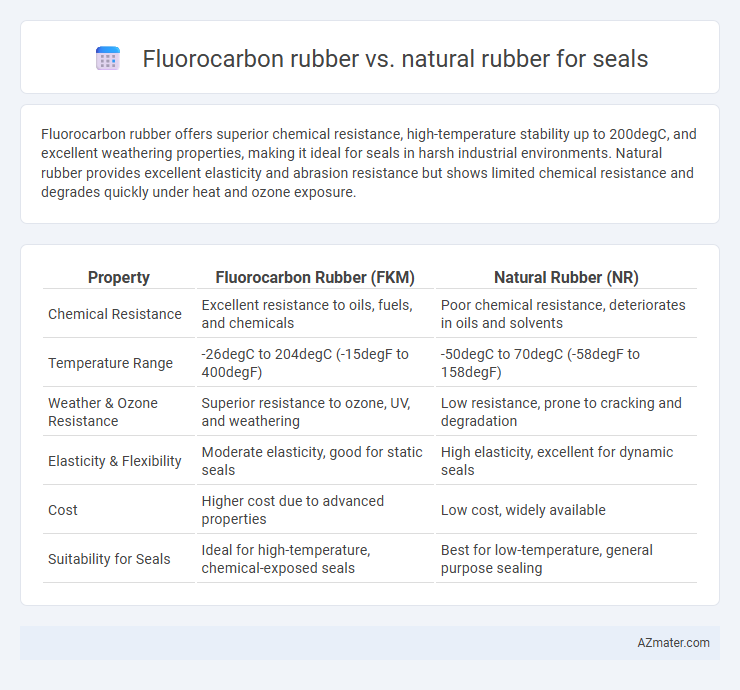Fluorocarbon rubber offers superior chemical resistance, high-temperature stability up to 200degC, and excellent weathering properties, making it ideal for seals in harsh industrial environments. Natural rubber provides excellent elasticity and abrasion resistance but shows limited chemical resistance and degrades quickly under heat and ozone exposure.
Table of Comparison
| Property | Fluorocarbon Rubber (FKM) | Natural Rubber (NR) |
|---|---|---|
| Chemical Resistance | Excellent resistance to oils, fuels, and chemicals | Poor chemical resistance, deteriorates in oils and solvents |
| Temperature Range | -26degC to 204degC (-15degF to 400degF) | -50degC to 70degC (-58degF to 158degF) |
| Weather & Ozone Resistance | Superior resistance to ozone, UV, and weathering | Low resistance, prone to cracking and degradation |
| Elasticity & Flexibility | Moderate elasticity, good for static seals | High elasticity, excellent for dynamic seals |
| Cost | Higher cost due to advanced properties | Low cost, widely available |
| Suitability for Seals | Ideal for high-temperature, chemical-exposed seals | Best for low-temperature, general purpose sealing |
Overview of Fluorocarbon Rubber and Natural Rubber Seals
Fluorocarbon rubber seals offer exceptional chemical resistance, high-temperature tolerance up to 250degC, and excellent durability in harsh environments, making them ideal for automotive and aerospace applications. Natural rubber seals provide superior flexibility, tensile strength, and abrasion resistance, suited for dynamic sealing tasks in low to moderate temperature ranges. Selection depends on application requirements, with fluorocarbon rubber excelling in chemical exposure scenarios while natural rubber is preferred for elasticity and cost-effectiveness.
Chemical Structure Differences
Fluorocarbon rubber (FKM) features a backbone primarily composed of carbon-carbon bonds with multiple fluorine atoms, providing exceptional chemical resistance and high-temperature stability compared to natural rubber's polyisoprene structure rich in unsaturated carbon-carbon double bonds. The strong carbon-fluorine bonds in fluorocarbon rubber create a densely cross-linked network resistant to oxidation, oils, and solvents, whereas natural rubber's double bonds are susceptible to degradation by ozone, heat, and chemicals. This fundamental chemical structure difference dictates their performance in sealing applications, with fluorocarbon rubber preferred for aggressive chemical environments and natural rubber favored for flexibility and elasticity under milder conditions.
Temperature Resistance Comparison
Fluorocarbon rubber offers superior temperature resistance, maintaining stability and performance in extreme heat environments up to 230degC, whereas natural rubber typically degrades above 70degC. This makes fluorocarbon seals ideal for high-temperature industrial applications involving oils, fuels, and chemicals. Natural rubber, with its limited thermal tolerance, suits lower-temperature sealing tasks but is prone to hardening and cracking when exposed to elevated temperatures.
Compatibility with Chemicals and Fluids
Fluorocarbon rubber exhibits superior compatibility with a wide range of chemicals and fluids, including fuels, oils, solvents, and acids, making it ideal for applications requiring chemical resistance. Natural rubber offers excellent compatibility with water and mild chemicals but deteriorates rapidly when exposed to oils, fuels, and harsh solvents. For sealing applications involving aggressive chemicals or high temperatures, fluorocarbon rubber provides enhanced durability and extended service life compared to natural rubber.
Mechanical Properties and Durability
Fluorocarbon rubber offers superior mechanical properties compared to natural rubber, including higher tensile strength, excellent resistance to abrasion, and exceptional heat tolerance up to 250degC, making it ideal for seals exposed to extreme environments. Its chemical resistance to oils, fuels, and solvents vastly enhances durability, ensuring longer service life in aggressive industrial applications. Natural rubber provides excellent elasticity and wear resistance under moderate temperatures but degrades faster when exposed to ozone, aging, and harsh chemicals, limiting its durability in demanding sealing applications.
Performance in Extreme Environments
Fluorocarbon rubber (FKM) outperforms natural rubber (NR) in extreme environments due to its superior resistance to high temperatures, chemicals, and ozone, maintaining elasticity and sealing integrity up to 200degC. Natural rubber exhibits excellent flexibility and resilience but degrades rapidly under exposure to heat, oils, and UV radiation, limiting its use in demanding applications. Fluorocarbon seals provide enhanced durability and reliability in aerospace, automotive, and chemical processing industries facing harsh operating conditions.
Cost Analysis and Economic Considerations
Fluorocarbon rubber seals typically incur higher upfront costs due to complex manufacturing processes and superior chemical resistance, making them ideal for high-performance, long-lasting applications. Natural rubber seals offer lower initial expenses and excellent flexibility but may require more frequent replacements in aggressive environments, leading to higher long-term maintenance costs. Evaluating total cost of ownership reveals fluorocarbon rubber's potential economic advantage in settings demanding durability, while natural rubber is cost-effective for less demanding uses.
Typical Applications for Each Material
Fluorocarbon rubber is widely used in seals for high-temperature environments and chemical resistance applications, such as aerospace fuel systems, automotive fuel injectors, and industrial chemical processing equipment. Natural rubber excels in seals requiring excellent elasticity and abrasion resistance, making it ideal for automotive tires, vibration dampers, and hydraulic system seals. Selection depends on operating temperature, chemical exposure, and mechanical stress to ensure optimal seal performance.
Longevity and Maintenance Requirements
Fluorocarbon rubber seals offer superior longevity due to their exceptional resistance to heat, chemicals, and aging, making them ideal for harsh industrial environments. Natural rubber seals, while more cost-effective and flexible, degrade faster under exposure to oils, ozone, and extreme temperatures, leading to higher maintenance demands. Choosing fluorocarbon rubber significantly reduces replacement frequency and maintenance costs, enhancing overall equipment reliability and operational efficiency.
Selecting the Right Rubber Seal for Your Needs
Fluorocarbon rubber offers superior chemical resistance, high-temperature tolerance up to 250degC, and excellent durability, making it ideal for seals in automotive, aerospace, and chemical processing industries. Natural rubber provides excellent elasticity, abrasion resistance, and is cost-effective, suitable for seals in low-temperature, non-chemical environments such as water and air systems. Selecting the right rubber seal depends on factors such as temperature range, chemical exposure, mechanical stress, and budget constraints to ensure optimal performance and longevity.

Infographic: Fluorocarbon rubber vs Natural rubber for Seal
 azmater.com
azmater.com